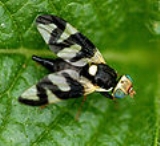
Urophora cardui
Encyclopedia
Urophora cardui or the Canada thistle gall fly is a fruit fly
which, contrary to its common name, is indigenous to Central Europe
from the United Kingdom
east to near the Crimea
, and from Sweden
south to the Mediterranean.
from Europe to control the population of its host plant, Canada, or creeping thistle, which is an invasive, introduced weed in North America.
, during the host's growing season. After hatching, the larva
e burrow into the stem of the plant and form a gall
(or swelling). During maturing, the larva will be 98% of its full body weight, and appear as an adult. The larvae pupa
te in early spring for 24 to 35 days, and appear reddish brown, but are still inside the gall. The fly goes through a tunnel formed in the gall during June to October.
Tephritidae
Tephritidae is one of two fly families referred to as "fruit flies", the other family being Drosophilidae. Tephritidae does not include the biological model organisms of the genus Drosophila , which is often called the "common fruit fly". There are nearly 5,000 described species of tephritid...
which, contrary to its common name, is indigenous to Central Europe
Central Europe
Central Europe or alternatively Middle Europe is a region of the European continent lying between the variously defined areas of Eastern and Western Europe...
from the United Kingdom
United Kingdom
The United Kingdom of Great Britain and Northern IrelandIn the United Kingdom and Dependencies, other languages have been officially recognised as legitimate autochthonous languages under the European Charter for Regional or Minority Languages...
east to near the Crimea
Crimea
Crimea , or the Autonomous Republic of Crimea , is a sub-national unit, an autonomous republic, of Ukraine. It is located on the northern coast of the Black Sea, occupying a peninsula of the same name...
, and from Sweden
Sweden
Sweden , officially the Kingdom of Sweden , is a Nordic country on the Scandinavian Peninsula in Northern Europe. Sweden borders with Norway and Finland and is connected to Denmark by a bridge-tunnel across the Öresund....
south to the Mediterranean.
Distribution
The Canada thistle gall fly has been introduced to North AmericaNorth America
North America is a continent wholly within the Northern Hemisphere and almost wholly within the Western Hemisphere. It is also considered a northern subcontinent of the Americas...
from Europe to control the population of its host plant, Canada, or creeping thistle, which is an invasive, introduced weed in North America.
Life cycle
The fly starts life as an egg, about one to thirty of them, laid on the stems of its host plant, the Canada thistle, Cirsium arvenseCirsium arvense
Cirsium arvense is a species of Cirsium, native throughout Europe and northern Asia, and widely introduced elsewhere. The standard English name in its native area is Creeping Thistle.-Alternate names:...
, during the host's growing season. After hatching, the larva
Larva
A larva is a distinct juvenile form many animals undergo before metamorphosis into adults. Animals with indirect development such as insects, amphibians, or cnidarians typically have a larval phase of their life cycle...
e burrow into the stem of the plant and form a gall
Gall
Galls or cecidia are outgrowths on the surface of lifeforms caused by invasion by other lifeforms, such as parasites or bacterial infection. Plant galls are abnormal outgrowths of plant tissues and can be caused by various parasites, from fungi and bacteria, to insects and mites...
(or swelling). During maturing, the larva will be 98% of its full body weight, and appear as an adult. The larvae pupa
Pupa
A pupa is the life stage of some insects undergoing transformation. The pupal stage is found only in holometabolous insects, those that undergo a complete metamorphosis, going through four life stages; embryo, larva, pupa and imago...
te in early spring for 24 to 35 days, and appear reddish brown, but are still inside the gall. The fly goes through a tunnel formed in the gall during June to October.

